Interprocess communication (IPC) allows processes to communicate through message passing. There are two main forms of IPC - synchronous which blocks sending and receiving processes, and asynchronous which is non-blocking for sending. IPC uses protocols like TCP and UDP, with TCP providing reliable, ordered streams and UDP providing unreliable datagram delivery. For communication, data must be serialized into a byte sequence and deserialized on the receiving end.
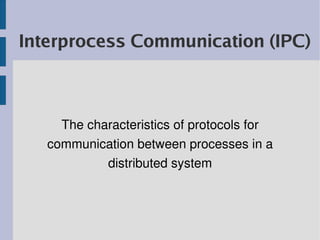

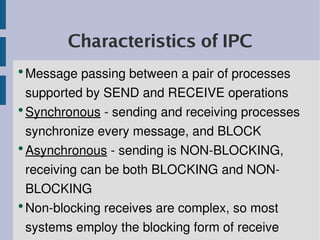
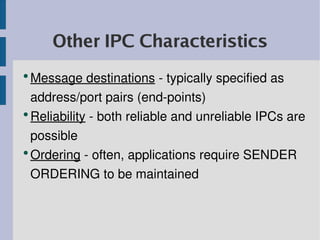
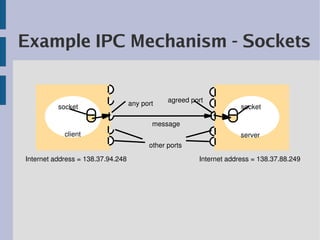

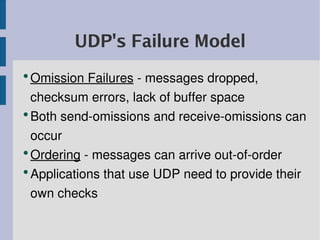

![Example UDP Client in Java
import java.net.*;
import java.io.*;
public class UDPClient{
public static void main(String args[]){
// args give message contents and server hostname
DatagramSocket aSocket = null;
try {
aSocket = new DatagramSocket();
byte [] m = args[0].getBytes();
InetAddress aHost = InetAddress.getByName(args[1]);
int serverPort = 6789;
DatagramPacket request = new DatagramPacket(m, args[0].length(), aHost,
serverPort);
aSocket.send(request);
byte[] buffer = new byte[1000];
DatagramPacket reply = new DatagramPacket(buffer, buffer.length);
aSocket.receive(reply);
System.out.println("Reply: " + new String(reply.getData()));
}catch (SocketException e){System.out.println("Socket: " + e.getMessage());
}catch (IOException e){System.out.println("IO: " + e.getMessage());}
}finally {if(aSocket != null) aSocket.close();}
}
}](https://image.slidesharecdn.com/ipc-111105115808-phpapp02/85/Ipc-9-320.jpg)
![Example UDP Server in Java
import java.net.*;
import java.io.*;
public class UDPServer{
public static void main(String args[]){
DatagramSocket aSocket = null;
try{
aSocket = new DatagramSocket(6789);
byte[] buffer = new byte[1000];
while(true){
DatagramPacket request = new DatagramPacket(buffer,
buffer.length);
aSocket.receive(request);
DatagramPacket reply = new DatagramPacket(request.getData(),
request.getLength(), request.getAddress(), request.getPort());
aSocket.send(reply);
}
}catch (SocketException e){System.out.println("Socket: " + e.getMessage());
}catch (IOException e) {System.out.println("IO: " + e.getMessage());}
}finally {if(aSocket != null) aSocket.close();}
}
}](https://image.slidesharecdn.com/ipc-111105115808-phpapp02/85/Ipc-10-320.jpg)
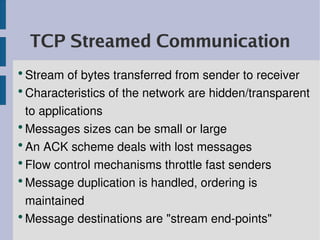



![Example TCP Client in Java
import java.net.*;
import java.io.*;
public class TCPClient {
public static void main (String args[]) {
// arguments supply message and hostname of destination
Socket s = null;
try{
int serverPort = 7896;
s = new Socket(args[1], serverPort);
DataInputStream in = new DataInputStream( s.getInputStream());
DataOutputStream out =
new DataOutputStream( s.getOutputStream());
out.writeUTF(args[0]); // UTF is a string encoding see Sn 4.3
String data = in.readUTF();
System.out.println("Received: "+ data) ;
}catch (UnknownHostException e){
System.out.println("Sock:"+e.getMessage());
}catch (EOFException e){System.out.println("EOF:"+e.getMessage());
}catch (IOException e){System.out.println("IO:"+e.getMessage());}
}finally {if(s!=null) try {s.close();}catch (IOException e)
{System.out.println("close:"+e.getMessage());}}
}
}](https://image.slidesharecdn.com/ipc-111105115808-phpapp02/85/Ipc-15-320.jpg)
![Example TCP Server in Java
import java.net.*;
import java.io.*;
public class TCPServer {
public static void main (String args[]) {
try{
int serverPort = 7896;
ServerSocket listenSocket = new ServerSocket(serverPort);
while(true) {
Socket clientSocket = listenSocket.accept();
Connection c = new Connection(clientSocket);
}
} catch(IOException e) {System.out.println("Listen :"+e.getMessage());}
}
}
class Connection extends Thread {
DataInputStream in;
DataOutputStream out;
Socket clientSocket;
public Connection (Socket aClientSocket) {
try {
clientSocket = aClientSocket;
in = new DataInputStream( clientSocket.getInputStream());
out =new DataOutputStream( clientSocket.getOutputStream());
this.start();
} catch(IOException e) {System.out.println("Connection:"+e.getMessage());}
}
public void run(){
try { // an echo server
String data = in.readUTF();
out.writeUTF(data);
} catch(EOFException e) {System.out.println("EOF:"+e.getMessage());
} catch(IOException e) {System.out.println("IO:"+e.getMessage());}
} finally{ try {clientSocket.close();}catch (IOException e){/*close failed*/}}
}
}](https://image.slidesharecdn.com/ipc-111105115808-phpapp02/85/Ipc-16-320.jpg)



























![The Request-Reply Protocol
public byte[] doOperation (RemoteObjectRef o, int methodId, byte[] arguments)
sends a request message to the remote object and returns the reply.
The arguments specify the remote object, the method to be invoked and the
arguments of that method.
public byte[] getRequest ();
acquires a client request via the server port.
public void sendReply (byte[] reply, InetAddress clientHost, int clientPort);
sends the reply message reply to the client at its Internet address and port.](https://image.slidesharecdn.com/ipc-111105115808-phpapp02/85/Ipc-44-320.jpg)








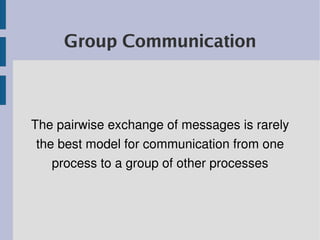
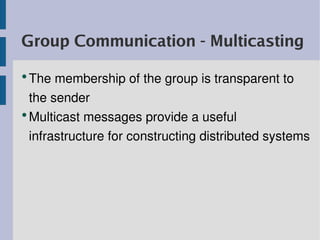




![Example Multicast Peer in Java
import java.net.*;
import java.io.*;
public class MulticastPeer{
public static void main(String args[]){
// args give message contents & destination multicast group (e.g. "228.5.6.7")
MulticastSocket s =null;
try {
InetAddress group = InetAddress.getByName(args[1]);
s = new MulticastSocket(6789);
s.joinGroup(group);
byte [] m = args[0].getBytes();
DatagramPacket messageOut =
new DatagramPacket(m, m.length, group, 6789);
s.send(messageOut);
// get messages from others in group
byte[] buffer = new byte[1000];
for(int i=0; i< 3; i++) {
DatagramPacket messageIn =
new DatagramPacket(buffer, buffer.length);
s.receive(messageIn);
System.out.println("Received:" + new String(messageIn.getData()));
}
s.leaveGroup(group);
}catch (SocketException e){System.out.println("Socket: " + e.getMessage());
}catch (IOException e){System.out.println("IO: " + e.getMessage());}
}finally {if(s != null) s.close();}
}
}](https://image.slidesharecdn.com/ipc-111105115808-phpapp02/85/Ipc-59-320.jpg)




